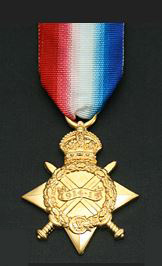Difference between revisions of "1914-15 Star"
From Our Contribution
(→Post WW1 arrivals in the district) |
|||
| Line 167: | Line 167: | ||
{| | {| | ||
|- | |- | ||
| − | |[[Ivor Trehane Birtwistle]] | + | |[[Ivor Trehane Birtwistle ]] |
| | | | ||
| − | |[[Reginald Thomas (Reg) Cockshott]] | + | |[[Reginald Thomas (Reg) Cockshott ]] |
| − | |[[Gordon Devereux MM]] | + | |[[Gordon Devereux MM ]] |
| − | |[[Spencer Gwynne DCM MiD]] | + | |[[Spencer Gwynne DCM MiD ]] |
| + | |[[William Hart]] | ||
|- | |- | ||
| − | |[[ | + | |[[Robert George McLean]] |
| | | | ||
| − | |||
|[[Reginald Grove Sexty MiD]] | |[[Reginald Grove Sexty MiD]] | ||
| + | |||
| | | | ||
|} | |} | ||
| − | |||
| − | |||
| − | |||
| − | |||
==Notes== | ==Notes== | ||
Revision as of 01:33, 6 May 2017
Contents
Eligibility
The 1914-15 Star was awarded to servicemen and servicewomen who served between 5 August 1914 and 31 December 1915 in any "theatre of war". This included service at Gallipoli between 25 April 1915 and 31 December 1915, service in Egypt between 5 November 1914 and 31 December 1915, and service during the capture of German Samoa on 29 August 1914. Those eligible for the medal must have "served on the establishment of a unit in a theatre of war" during the relevant dates of operations in that area.[1]
Description
The 1914-15 Star is a crowned four-pointed star with crossed swords and a wreath of oak leaves, with the royal cypher at the foot and a central scroll inscribed 1914-15. The 1914-15 Star is identical to the 1914 Star, except for the omission of AUG and NOV, and the scroll across the centre being inscribed 1914-15. The reverse of the 1914-15 Star is plain, except for the inscribed name and service details of the recipient. The medal is bronze and is attached to the ribbon by a ring.
Throughout the British Empire more than 2.35 million 1914-15 Stars were awarded.
Awarded to:
Post WW1 arrivals in the district
| Ivor Trehane Birtwistle | Reginald Thomas (Reg) Cockshott | Gordon Devereux MM | Spencer Gwynne DCM MiD | William Hart | |
| Robert George McLean | Reginald Grove Sexty MiD |
Notes
Initially this medal was not intended for those who fought at Gallipoli. Instead it had been proposed that a 'Gallipoli Star', or 'ANZAC Star' would be given to Australian and New Zealand troops. However, there was unease in Britain that men from other Commonwealth nations would not be eligible and so, despite it having been approved by King George V, it was substituted with the 1914-15 Star.[2]
In 1967 Gallipoli specific service was rewarded in Australia and New Zealand with the issue of a Gallipoli Medal (not intended to be worn) to those who were eligible, or their next of kin.
References
- ↑ http://medals.nzdf.mil.nz/category/h/h5.html
- ↑ The Oxford Companion to New Zealand Military History (Oxford University Press, Auckland, 2000), p.226
